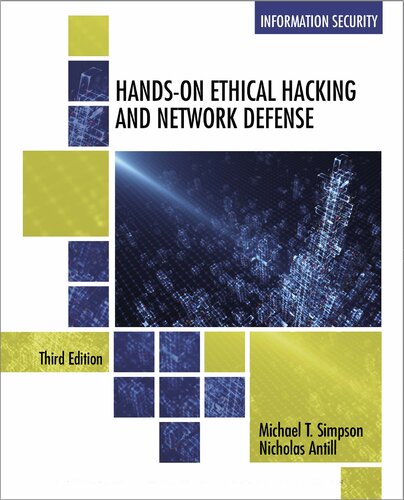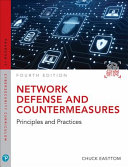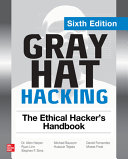Hands On Ethical Hacking and Network Defense 3rd Edition by Michael Simpson, Nicholas Antill 9798214344973
$50.00 Original price was: $50.00.$25.00Current price is: $25.00.
Hands-On Ethical Hacking and Network Defense 3rd Edition by Michael T. Simpson, Nicholas Antill – Ebook PDF Instant Download/DeliveryISBN: 9798214344973
Full download Hands-On Ethical Hacking and Network Defense 3rd Edition after payment.

Product details:
ISBN-13 : 9798214344973
Author : Michael T. Simpson, Nicholas Antill
Cyber-terrorism and corporate espionage are increasingly common and devastating threats, making trained network security professionals more important than ever. This timely text helps readers gain the knowledge and skills to protect networks using the tools and techniques of an ethical hacker. The authors begin by exploring the concept of ethical hacking and its practitioners, explaining their importance in protecting corporate and government data from cyber attacks. The text then provides an in-depth guide to performing security testing against computer networks, covering current tools and penetration testing methodologies. Updated for today’s cyber security environment, the Third Edition of this trusted text features new computer security resources, coverage of emerging vulnerabilities and innovative methods to protect networks, a new discussion of mobile security, and information on current federal and state computer crime laws, including penalties for illegal computer hacking.
Hands-On Ethical Hacking and Network Defense 3rd Table of contents:
Chapter 1. Ethical Hacking Overview
Introduction to Ethical Hacking
The Role of Security and Penetration Testers
Penetration-Testing Methodologies
Certification Programs for Network Security Personnel
What You Can Do Legally
Laws of the Land
Is Port Scanning Legal?
Federal Laws
What You Cannot Do Legally
Get It in Writing
Ethical Hacking in a Nutshell
Chapter Summary
Key Terms
Review Questions
Case Projects
Chapter 2. TCP/IP Concepts Review
Overview of TCP/IP
The Application Layer
The Transport Layer
The Internet Layer
IP Addressing
CIDR Notation
Planning IP Address Assignments
IPv6 Addressing
Overview of Numbering Systems
Reviewing the Binary Numbering System
Reviewing the Octal Numbering System
Reviewing the Hexadecimal Numbering System
Reviewing the Base-64 Numbering System
Chapter Summary
Key Terms
Review Questions
Case Projects
Chapter 3. Network and Computer Attacks
Malicious Software (Malware)
Viruses
Macro Viruses
Worms
Trojan Programs
Spyware
Adware
Protecting Against Malware Attacks
Educating Your Users
Intruder Attacks on Networks and Computers
Denial-of-Service Attacks
Distributed Denial-of-Service Attacks
Buffer Overflow Attacks
Eavesdropping
Man-in-the-Middle
Network Session Hijacking
Addressing Physical Security
Keyloggers
Behind Locked Doors
Chapter Summary
Key Terms
Review Questions
Case Projects
Chapter 4. Footprinting and Social Engineering
Using Web Tools for Footprinting
Conducting Competitive Intelligence
Analyzing a Company’s Web Site
Using Other Footprinting Tools
Using E-Mail Addresses
Using HTTP Basics
Other Methods of Gathering Information
Using Domain Name System Zone Transfers
Introduction to Social Engineering
The Art of Shoulder Surfing
The Art of Dumpster Diving
The Art of Piggybacking
Phishing
Chapter Summary
Key Terms
Review Questions
Case Projects
Chapter 5. Port Scanning
Introduction to Port Scanning
Types of Port Scans
Using Port-Scanning Tools
Nmap
Nessus and OpenVAS (or Greenbone Security Assistant)
Conducting Ping Sweeps
Fping
Hping
Crafting IP Packets
Understanding Scripting
Scripting Basics
Chapter Summary
Key Terms
Review Questions
Case Projects
Chapter 6. Enumeration
Introduction to Enumeration
Enumerating Windows Operating Systems
NetBIOS Basics
NetBIOS Null Sessions
NetBIOS Enumeration Tools
Additional Enumeration Tools
Enumerating *nix Operating System
*nix Enumeration
Chapter Summary
Key Terms
Review Questions
Case Projects
Chapter 7. Programming for Security Professionals
Introduction to Computer Programming
Programming Fundamentals
Learning the C Language
Anatomy of a C Program
Understanding HTML Basics
Creating a Web Page with HTML
Understanding Perl
Background on Perl
Understanding the Basics of Perl
Understanding the BLT of Perl
Understanding Object-Oriented Programming Concepts
Components of Object-Oriented Programming
An Overview of Ruby
Chapter Summary
Key Terms
Review Questions
Case Projects
Chapter 8. Desktop and Server OS Vulnerabilities
Windows OS Vulnerabilities
Windows File Systems
Remote Procedure Call
NetBIOS
Server Message Block
Common Internet File System
Null Sessions
Web Services
MS SQL Server
Buffer Overflows
Passwords and Authentication
Tools for Identifying Vulnerabilities in Windows
Built-in Windows Tools
Best Practices for Hardening Windows Systems
Patching Systems
Antivirus Solutions
Enable Logging and Review Logs Regularly
Disable Unused Services and Filtering Ports
Other Security Best Practices
Linux OS Vulnerabilities
Samba
Tools for Identifying Linux Vulnerabilities
More Countermeasures Against Linux Attacks
Chapter Summary
Key Terms
Review Questions
Case Projects
Chapter 9. Embedded Operating Systems: The Hidden Threat
Introduction to Embedded Operating Systems
Windows and Other Embedded Operating Systems
Other Proprietary Embedded OSs
*nix Embedded OSs
Vulnerabilities of Embedded OSs
Embedded OSs Are Everywhere
Embedded OSs Are Networked
Embedded OSs Are Difficult to Patch
Embedded OSs Are in Networking Devices
Embedded OSs Are in Network Peripherals
Supervisory Control and Data Acquisition Systems
Cell Phones, Smartphones, and PDAs
Rootkits
Best Practices for Protecting Embedded OSs
Chapter Summary
Key Terms
Review Questions
Case Projects
Chapter 10. Hacking Web Servers
Understanding Web Applications
Web Application Components
Using Scripting Languages
Connecting to Databases
Understanding Web Application Vulnerabilities
Application Vulnerabilities and Countermeasures
Web Application Test Execution
Tools for Web Attackers and Security Testers
Web Tools
Chapter Summary
Key Terms
Review Questions
Case Projects
Chapter 11. Hacking Wireless Networks
Understanding Wireless Technology
Components of a Wireless Network
Understanding Wireless Network Standards
The 802.11 Standard
An Overview of Wireless Technologies
Additional IEEE 802.11 Projects
Understanding Authentication
The 802.1X Standard
Understanding Wardriving
How It Works
Understanding Wireless Hacking
Tools of the Trade
Countermeasures for Wireless Attacks
Chapter Summary
Key Terms
Review Questions
Case Projects
Chapter 12. Cryptography
Understanding Cryptography Basics
History of Cryptography
Understanding Symmetric and Asymmetric Algorithms
Symmetric Algorithms
Asymmetric Algorithms
Digital Signatures
Sensitive Data Encryption
Hashing Algorithms
Understanding Public Key Infrastructure
Components of PKI
Understanding Cryptography Attacks
Birthday Attack
Mathematical Attack
Brute-Force Attack
Man-in-the-Middle Attack
SSL/TLS Downgrade Attack
Dictionary Attack
Replay Attack
Understanding Password Cracking
Chapter Summary
Key Terms
Review Questions
Case Projects
Chapter 13. Network Protection Systems
Understanding Network Protection Systems
Understanding Routers
Understanding Basic Hardware Routers
Understanding Access Control Lists
Understanding Firewalls
Understanding Firewall Technology
Implementing a Firewall
Understanding the Cisco Adaptive Security Appliance Firewall
Using Configuration and Risk Analysis Tools for Firewalls and Routers
Understanding Intrusion Detection and Prevention Systems
Network-Based and Host-Based IDSs and IPSs
Web Filtering
Security Operations Center (SOC)
Understanding Honeypots
How Honeypots Work
People also search for Hands-On Ethical Hacking and Network Defense 3rd:
hands-on ethical hacking and network defense 4th edition pdf
hands-on ethical hacking and network defense 4th edition
hands-on ethical hacking and network defense 3rd edition
hands-on ethical hacking and network defense 4th ed
hands-on ethical hacking and network defense 3rd edition free pdf
Tags:
Hands On Ethical,Hacking,Network Defense,Michael Simpson,Nicholas Antill
You may also like…
Forensic Science
Computers - Security
Gray Hat Hacking: The Ethical Hacker’s Handbook, Sixth Edition Daniel Regalado
Computers - Networking
Computers & Technology
Computers - Networking
Computers - Security
Gray Hat Hacking: The Ethical Hacker’s Handbook, Fifth Edition Daniel Regalado
Computers - Security
Gray Hat Hacking: The Ethical Hacker’s Handbook, Sixth Edition Daniel Regalado












